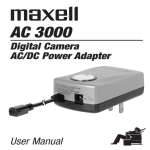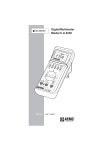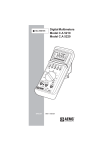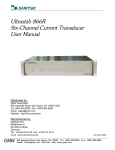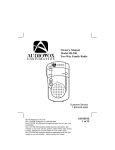Download INSTRUCTION MANUAL for UNIBLITZ® MODEL D880 SHUTTER
Transcript
INSTRUCTION MANUAL for UNIBLITZ® MODEL D880 SHUTTER DRIVER Vincent Associates 803 Linden Ave. Rochester, New York 14625 Service/Orders 800/828-6972 In NY State 585/385-5930 Fax (585) 385-6004 A Division of VA, Inc. Version 1.5 2003 TABLE OF CONTENTS INTRODUCTION ......................................................................................... Page 3 FEATURES ................................................................................................... Page 3 SPECIFICATIONS......................................................................................... Page 4 Input Characteristics.............................................................................. Page 4 Output Characteristics........................................................................... Page 4 OPERATING INSTRUCTIONS..................................................................... Page 5 Operation.............................................................................................. Page 5 Triggering Methods..................................................................... Page 5 MISCELLANEOUS....................................................................................... Page 6 Using Synchronization.......................................................................... Page 6 External Low Voltage Power Supply..................................................... Page 6 Cable Layout - 710P............................................................................. Page 6 MAINTENANCE........................................................................................... Page 6 WARRANTY…............................................................................................. Page 7 NOTES…………........................................................................................... Page 7 D880 CONTROL DIAGRAM.............................................................. Dwg. 16-0111 D880 OUTLINE DIAGRAM................................................................ Dwg. 16-0109 2 INTRODUCTION The D880 is the most advanced drive system available for UNIBLITZ shutter units. Its unique design has proven in test after test to provide shutter systems (specified with an "E" designation) an operational life in excess of 20 million operations. The versatility of the D880 allows it to operate all apertures in the UNIBLITZ line. Dwell time is only limited to the shutter's mechanical ability and not to the charge of a capacitor. A shutter will now operate at different frequencies without a change in rise time. The user can now take complete advantage of the shutter's <2% repeatability from exposure to exposure, no longer limited by dwell time. The D880, as with all of our shutter drivers, provides a low voltage output that allow a number of different external triggering methods. This, in addition to the pluggable input/output connector, give the user a distinct advantage when implementing the unit into a specific application. Please read the entire manual carefully before attempting to operate the unit. FEATURES 20 Million Plus Exposures Proprietary drive system in conjunction with the "E" designation can provide this life. Compatible with All Apertures The D880 can be factory adjusted to operate all Vincent shutter apertures with the exception on the VS35. Open Frame Printed Circuit Small size will allow the unit to be implemented into many space critical OEM applications. Triggering Options The unit can be triggered from a switch contact closure or an active high, +5VDC, logic signal. DC Power Input The unit will operate from user supplied +24VDC 1.5A power supply. Pluggable I/O Connector Allows quick I/O connection. 3 SPECIFICATIONS Input Characteristics Signal Input (Pin 10) Input impedance 20K ohms. Max. input voltage +20VDC (100% duty cycle). Min. input voltage necessary to ensure triggering +1.5VDC. Nominal input trigger voltage +5VDC logic signal (TTL or CMOS). Min. pulse width will be determined by shutter used. Max. pulse width determined by exposure time desired. Input signals can be provided from most pulse sources or from mechanical/electronic switch contact closures. Power Requirements (Pin 1) +24VDC at 1.5ADC for operating a shutter to its max. frequency response (determined by shutter used). For single exposures or for low frequency requirements, the power supply must be able to supply 1.5ADC for a 50ms duration. External Low Voltage Input (Pin 9) (Remove shunt from JP1 move to JP2 to activate this input) +7.4VDC at .600ADC for shutter hold voltage. Will also disable on board step down switching regulator. (Note-with shunt in JP1 Pin 9 is a Ground point. Be sure that both shunts are not in at the same time.) Output Characteristics Shutter Output (Pin 7) A (Pin 8) B Low Voltage Supply Output Electronic Sync. Out Proprietary output signal to provide for extended shutter life. Output will follow input signal. (Pin 4) (Pin 12) +6.75VDC at 50ma available to the user for use in remote switching into signal input and for external circuit biasing. Provides output for shutter equipped with electronic sync. system. Active high >3.5VDC when the shutter is activated. <0.5VDC when deactivated. General Repeat Exposure Minimum time between exposures is determined by shutter used. Size (HWD) 1.0 x 3.2 x 4.0 inches (2.54 x 8.12 x 10.16 cm). Weight 3 oz.(.09 kg) Input/Output Connector 12 pole in-line pluggable terminal strip. Wire size - 12AWG max. 4 OPERATING INSTRUCTIONS Operation ***Please observe anti-static unpacking procedure when removing the D880 from the static shielding bag. Improper handling can result in destruction of the CMOS integrated circuits located on the board surface.*** The D880 provides the circuitry necessary to efficiently drive UNIBLITZ shutter units. By providing the unit with the necessary initiating control signal, the shutter can be made to open and close on command. The circuitry is precisely matched to provide UNIBLITZ shutters a life time which can exceed 20M operations. Prior to the connection of input/output signals to the D880 remove the pluggable I/O connector (TS1) from the printed circuit board unit and set printed circuit board unit aside. (TS1 connector can be removed by grasping hold of both sides and pulling it away from the printed circuit board. A slight rocking motion from side to side will aid in the plug's removal.) Make all connections to TS1 connector prior to mating it with the printed circuit board unit. Typical connections will include a +24VDC power supply and the user specified shutter unit. Additional connections will be determined by the type of triggering needed for your particular application. See dwg. #16-0111 to determine your particular controlling method. Reference dwgs. #16-0111 and #16-0109 for proper connections to D880. Begin by connecting the power supply. Connect the (+) positive wire (RED) of the supply to PIN #1. Connect the (-) (BLACK) return wire and (GREEN) ground wire of the power supply to PIN #2. ***CAUTION, failure to connect the power supply properly will result in extensive damage to the drive unit and/or power supply.*** Triggering Methods Next determine the method of triggering you will be using. See dwg. #16-0111. This diagram shows three typical methods of triggering the D880. The first method is a simple switch contact closure. By connecting a switch or relay contact as shown, the shutter will open and remain open for as long as the switch is in the closed position. The second method is an external pulse source. This pulse source can be provided from a pulse generator, a single bit from a computer parallel port, or any equivalent pulse source. A common ground must also be maintained. By connecting a pulse source as shown in dwg. #16-0111, as long as the pulse remains in the high state the shutter will remain in the open position. When using this method of control, be sure to note the minimum equivalent exposure time (MEET) of the shutter. If the pulse width input is less than the MEET, the shutter may only open partially or not at all. (This will be true for all triggering methods.) The last method of triggering shown is a transistor switch closure, it is similar to the mechanical switch closure except the correct polarity must be maintained and all grounds must be common. When using the NPN type of transistor shown (or an equivalent type, as in an opto-isolator) the collector lead of the transistor must be connected to the +6.75VDC (PIN #4) of the D880 and the emitter lead must be connected to the trigger input (PIN #10). Also be sure that the driving circuit ground is connected to the ground (PIN #11) of the D880. If you are using an equivalent transistor type the maximum input current is 1mA. Caution Please note that the D880 drive unit is capable of driving only one shutter. Attempts to drive multiple shutters from one drive unit may cause irreparable damage to the drive unit and/or shutter. This may also cause the power supply to be become overloaded or the shutters may not operate to published specifications. See page #6 for additional details regarding driving multiple shutters. 5 MISCELLANEOUS The repeat exposure specification listed in this manual is limited only to the type of shutter used. At higher frequencies (above 15Hz.) heat could begin to rise in the shutter coil especially if the shutter is enclosed in an area of limited air flow. This heat in the shutter coil could cause premature failure. Please contact the factory for specific information concerning shutter modifications and/or drive modifications that may be necessary for operating shutters at their maximum frequency. Please also note that the shutter outputs are NOT fuse protected. This protection (if desired) must be provided by the user. Contact the factory for further details regarding specific fuse selection. Under certain circumstances multiple D880 drive units can be operated from one power supply. If your requirements do not necessitate shutters to open at the same instance, two drivers may be operated from one supply. It would be advisable to discuss your particular application with one of our customer service representatives. Using Synchronization The D880 can also be utilized to operate the electronic sync. switch (if the electronic sync. is included with the shutter used). The electronic sync will provide a signal directly from the shutter mechanism (through the D880 controller, see dwg. #16-0109) when the shutter achieves 90% of its full aperture. The electronic sync. output (pin 12) will provide >3.5VDC when the shutter is placed at the open position (logic 1), and <.5VDC when the shutter is closed (logic 0) provided the shutter is properly connected to the D880 as shown. External Low Voltage Power Supply Input (Optional) The D880 derives its shutter hold voltage from the +24VDC power supply via an on board step down switching regulator operating at 52KHz. If this switching frequency will interfere with the user application into which the D880 will be used, the on board regulator can be disabled. This is accomplished by removing shunt JP1 and placing it at JP2. This changes Pin 9 from a convenient ground terminal to a +7.4VDC input. This external voltage disables the on board regulator, supplies low voltage bias to the circuit, and provides the shutter holding current. The external supply used must be capable of supplying 600mA for proper circuit operation. Cable Layout - 710P The following is the layout of the 710P cable that is included with the D880. PIN # (7-PIN) A B C D E F H FUNCTION Shutter Coil Shutter Coil Sync. Control Ground (circuit) Sync. Control +6.75VDC Ground (shutter) WIRE COLOR RED BLACK WHITE GREEN ORANGE BLUE BROWN PIN # (D880) 7 8 3 6 5 4 9 MAINTENANCE Although the stability of the drive voltage is assured and calibrated prior to shipment, it may become necessary to make some minor adjustments to the operating systems of the D880 over time. 6 It is highly recommended that if you suspect a problem with your unit that it be returned to the factory for proper adjustments and calibration. The unit's complicated circuitry may be damaged and/or not function as specified if adjusted improperly. Proper care and maintenance of the unit should be taken as with any electronic instrument. WARRANTY Great care has been taken to ensure that our products are free from defect when shipped. Defective units will be replaced or repaired at no charge, excepting transportation charges, if returned within 90 days from the date of shipment. Vincent Associates will consider the return of unused equipment if returned within 30 days from the date of shipment subject to a 20% restocking charge. This offer does not apply to used or damaged equipment. NOTES 7 8 9











